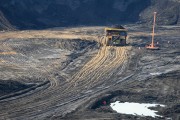With the U.S. Department of State's decision on the Keystone XL pipeline delayed until 2013, much of the attention in Canada has been shifting west towards Enbridge's proposed Northern Gateway Pipeline to the B.C. coast. After the Keystone XL announcement, Prime Minister Stephen Harper was quick to threaten to ship oilsands crude to Asia — a point the Prime Minister will likely repeat when he meets with President Obama tomorrow.
Last week, the Pembina Institute, the Natural Resources Defence Council (NRDC) and Living Oceans Society released a new report, Pipeline and Tanker Trouble: the impact to British Columbia's communities, rivers and Pacific coast line from tar sands oil transport. The report was intended to serve as an accessible resource to British Columbians who would like to learn more about the potential impacts from Enbridge's proposed Northern Gateway oilsands pipeline, from upstream production to transport by pipeline to shipping in tankers.
 The report found there are unique challenges associated with transporting oilsands oil as opposed to other forms of oil. For instance, it sinks in water, making cleanup very challenging, and may lead to increased corrosion in pipelines. Pipeline and Tanker Trouble also outlines the additional risks to tankers carrying oilsands crude, highlights the risks from unstable, landslide-prone terrain along the proposed route and the risks to First Nations communities and B.C.'s salmon fisheries.
The report found there are unique challenges associated with transporting oilsands oil as opposed to other forms of oil. For instance, it sinks in water, making cleanup very challenging, and may lead to increased corrosion in pipelines. Pipeline and Tanker Trouble also outlines the additional risks to tankers carrying oilsands crude, highlights the risks from unstable, landslide-prone terrain along the proposed route and the risks to First Nations communities and B.C.'s salmon fisheries.
Looking back at the media coverage last week, the report received significant attention in the national and British Columbia news media. Enbridge chose to downplay the concerns raised in the report, calling it "fear-mongering" and suggesting the authors were pushing for unrealistic safety standards. Paul Stanway, an Enbridge spokesperson who commented on Enbridge's approach to risk management, said, "It depends on where you place the bar. Our aim is to make this a safe project, to build and operate Northern Gateway as safely as humanly possible."
It does depend on where you place the bar. Given the significant opposition from British Columbians and First Nations, the environmental impacts from oilsands production and the unique landscape and livelihoods that would be at risk, the bar for Enbridge should be set accordingly high.
Alternatively, one could use Enbridge's logic and simply lower the bar to the point where concerns seem unreasonable and the project can proceed.
Enbridge has said that it has been aware from the beginning that Gateway is a "controversial project." This has certainly proven to be the case. As such, instead of lowering the bar and choosing to ignore the environmental impacts from expanded oilsands development necessary to fill this pipeline, the federal government should strive to set the bar high, consider both positive and negative impacts from the project and exceed the expectations of Canadians for a thorough and objective review to determine whether this pipeline is in the public interest.
The Pembina Institute's perspective on oilsands pipelines
 As an organization that has spent nearly two decades working on the regional impacts of oilsands development, we are solutions-oriented and have long advocated for responsible oilsands development. Only when upstream oilsands impacts, including regional environmental impacts and growing greenhouse gas pollution, have been adequately addressed would it be appropriate to consider which transportation routes would maximize benefits and minimize environmental risks and impacts. Until then, it is irresponsible to approve new pipeline capacity — if you build it, you will fill it.
As an organization that has spent nearly two decades working on the regional impacts of oilsands development, we are solutions-oriented and have long advocated for responsible oilsands development. Only when upstream oilsands impacts, including regional environmental impacts and growing greenhouse gas pollution, have been adequately addressed would it be appropriate to consider which transportation routes would maximize benefits and minimize environmental risks and impacts. Until then, it is irresponsible to approve new pipeline capacity — if you build it, you will fill it.
In the case of Gateway, there are additional challenges beyond the upstream impacts.
On top of the regional and climate implications of oilsands development in Alberta, there are increasing market concerns, real risks and growing liabilities coming from downstream customers of oilsands — whether from Americans concerned about the risks of oilsands pipelines, or Europeans wanting to reduce the carbon emissions from their transportation sector.
Until these upstream issues are adequately addressed, there will continue to be downstream concerns. The response to these concerns will have impacts on both market access and Canada's international reputation and credibility on the environment and sustainable development.
In addition, unprecedented opposition from First Nations and British Columbians, a hazardous and unstable pipeline route and significant risks from oil supertanker traffic along B.C's coast together make the pipeline a very tough sell.
Time to raise the bar
As the Joint Review Panel for the Northern Gateway pipeline begins their public consultation in January, it will be critical for the Panel to listen to the concerns of First Nations and British Columbians and consider the issues raised in Pipeline and Tanker Trouble. More than 4,000 people — an unprecedented number — have signed up for the public consultation to share their perspectives on the pipeline with the Panel.
Given the amount of public criticism this pipeline proposal is creating, instead of lowering the bar for Enbridge, the federal government should listen to the vocal opposition to the pipeline and raise the bar for how the project is evaluated and considered. Until that happens, there remains little room for the federal government to declare that this review process will lead to an informed decision that reflects the interest of Canadians.









